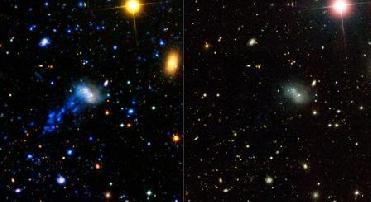
The star-studded tail can be seen on the left, as detected by the space telescope in ultraviolet light. The tail has escaped detection in visible light, as shown by the image on the right, taken by a visible-light telescope on the ground. NASA/JPL-Caltech photo
PASADENA (BNS): NASA's Galaxy Evolution Explorer has discovered a galaxy tail studded with bright knots of new stars.
The tail, which was created as the galaxy IC 3418 plunged into the neighboring Virgo cluster of galaxies, offers new insight into how stars form.
"The gas in this galaxy is being blown back into a turbulent wake," said Janice Hester of the California Institute of Technology in Pasadena, lead author of a recent study published in the Astrophysical Journal Letters.
"The gas is like sand caught up by a stiff wind. However, the particular type of gas that is needed to make stars is heavier, like pebbles, and can't be blown out of the galaxy.
The new Galaxy Evolution Explorer observations are teaching us that this heavier, star-forming gas can form in the wake, possibly in swirling eddies of gas."
Hester and her team found IC 3418 is mingling not with one galaxy, but with the entire Virgo cluster of galaxies 54 million light-years away from Earth.
This massive cluster, which contains about 1,500 galaxies and is permeated by hot gas, is pulling in IC 3418, causing it to plunge through the cluster's gas at a rate of 1,000 kilometers per second, or more than 2 million miles per hour.
The astronomers were able to find this tail with the help of the Galaxy Evolution Explorer. Clusters of massive, young stars speckle the tail, and these stars glow with ultraviolet light that the space telescope can see.
The young stars tell scientists that a crucial ingredient for star formation - dense clouds of gas called molecular hydrogen - formed in the wake of this galaxy's plunge.
This is the first time astronomers have found solid evidence that clouds of molecular hydrogen can form under the violent conditions present in a turbulent wake.
 Previous Article
Previous Article Next Article
Next Article












The Indian Air Force, in its flight trials evaluation report submitted before the Defence Ministry l..
view articleAn insight into the Medium Multi-Role Combat Aircraft competition...
view articleSky enthusiasts can now spot the International Space Station (ISS) commanded by Indian-American astr..
view article